|
|
|
The Communications Institute's
National Energy Symposium #1
Speaker Index and Audio Recordings
June 15, 2006
University of Southern California
Los Angeles, California
|
Introduction and Welcome
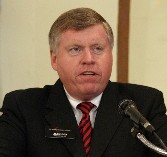
Photo: Amy Tierney
John E. Cox, Jr., President, The Communications Institute
|
| Yannis Yortsos, Dean, Viterbi School of Engineering, University of Southern California |
|
Energy Choices and Policies: Putting the Issues in Perspective (subsequent Q&A session)
An overview of the energy choices and public policies that confront the United States in meeting the nation's energy needs.
| Henry Lee, Ph.D., Director, Environment and Natural Resources Program, John F. Kennedy School of Government, Harvard University |
|
Energy Sources for the Future (subsequent Q&A session)
This session reviewed the major sources of energy now available in the United States. Panelists discussed the future direction, advantages and limitations of each source, and the prospects for new sources to replace fossil fuel energy. The panel included experts in petroleum, nuclear, solar and new materials, synthetic fuels, hydrogen and coal.
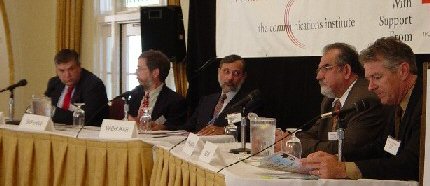
| Panelists (left to right): |
| Craig Smith, Senior Scientist, Lawrence Livermore National Laboratory (nuclear energy expert) |
| John Sheehan, Senior Strategic Analyst, National Renewable Energy Laboratory |
| Anupam Madhukar, Ph.D., Professor of Engineering, Department of Chemical Engineering & Materials, University of Southern California (solar and new materials expert) |
| Iraj Ershaghi, Ph.D., P.E., Omar B. Milligan Professor and Director, Petroleum Engineering Program, Viterbi School of Engineering, University of Southern California |
| Conan Nolan, Correspondent, NBC4 News (moderator) |
|
Efficiency in Energy: Cost and Environmental Balance (subsequent Q&A session)
Improving energy efficiency and developing new technologies will impact the global economy, environment and cost of energy. Over the next 20 years global demand is expected to increase by 40 percent. Improving energy efficiency has been a key element in the debate to create a cleaner environment. However, what are the economic and technological limitations to achieving these goals?
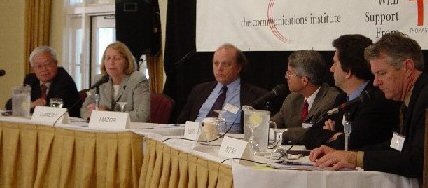
| Panelists (left to right): |
| Tsen-Chung Cheng, Lloyd F. Hunt Chair in Electrical Power Engineering and Professor of Electrical Engineering/Electrophysics, University of Southern California |
| Beth Lowery, Vice President, Environment and Energy, General Motors |
| Steven Daniel Mazor, Chief Automotive Engineer/Manager, Automobile Club Of Southern California |
| Pedro Pizarro, Senior Vice President for Power Procurement, Southern California Edison |
| Paul D. Ronney, Ph.D., Professor of Aerospace and Mechanical Engineering, University of Southern California, Former NASA Astronaut |
| Conan Nolan, Correspondent, NBC4 News (moderator) |
|
Energy Policy for the Future (subsequent Q&A session)
Policy makers at every level of government are faced with issues ranging from energy costs to availability to production. This session featured top experts discussing the future direction of energy policy on a national and state level.
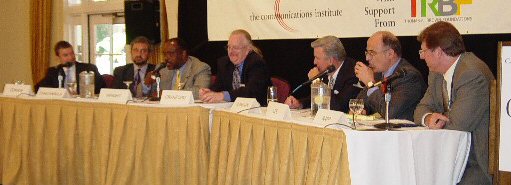
| Panelists (left to right): |
| Michael Zenker, Managing Director, Cambridge Energy Research Associates |
| Assemblyman Joseph Canciamilla, ( D-Contra Costa County) |
| Roderick Wright, Chairman, California State Assembly Committee on Utilities and Commerce (1998-2002) |
| John Cranford, National Editor and Economics Columnist, Congressional Quarterly |
| James Flanigan, New York Times Contributor; former Economics Editor, Los Angeles Times |
| Henry Lee, Ph.D., Director, Environment and Natural Resources Program, John F. Kennedy School of Government, Harvard University |
| Moderator: David Rapp, Editor & Senior Vice President, Congressional Quarterly |
|
Our Energy Future: Summing Up the Options (subsequent Q&A session)
Science and engineering have been and will continue to be the building blocks for the nation's energy future. They are critical to the development of new technology that may be more environmentally friendly. It is important that policy makers and leaders from all sectors understand the current state of technology and the viability of current and new sources.
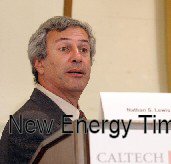
Photo: Amy Tierney
Nathan S. Lewis, Ph.D., George L. Argyros Professor and Professor of Chemistry, Caltech
Powerpoint Presentation
|
|
|
|
|

